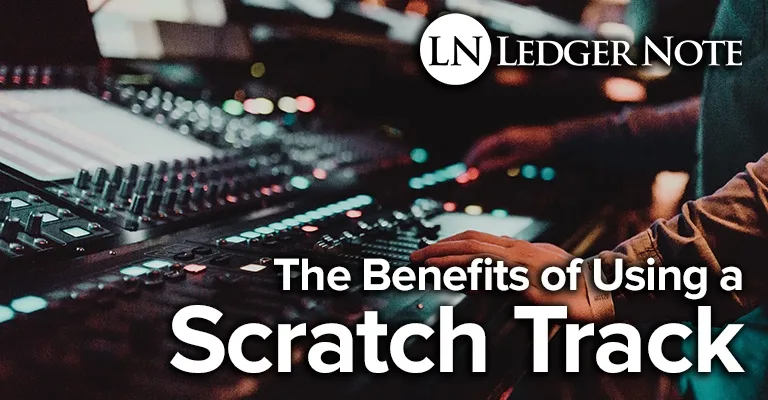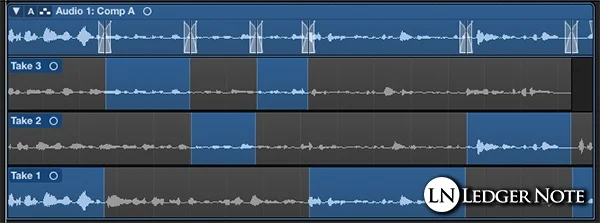
A scratch track, sometimes called a guide track, may seem like a waste of time to a cocky, over-confident amateur or a money-conscious renter of an expensive studio, but it provides tons of benefits you may not realize just yet.
If you do like you should and surrender to the process of the studio engineer, he or she will undoubtedly first guide you through laying down a scratch track or two. If you ask they’ll explain why, but maybe you’re embarrassed and don’t want to come off as a newbie.
Well, worry not. I’ll tell you all about why this is standard practice and the many benefits that come alongside doing it. In addition, I’ll give you some food for thought about the different ways you can go about laying down these temporary recordings.
What is a Scratch Track?
A scratch track is a rough, imperfect recording of a full song created prior to attempting to capture better takes of each instrument’s parts.
Very few bands or artists can roll into the studio, do a single take and have a record-ready song completed. The process of providing studio quality recordings happens in several stages, the first of which is to lay down these temporary recordings.
Usually, there are several of these tracks, sometimes containing several instruments at a time or just one. Each instrumentalist will use a different scratch take to help them with their own performance, while providing their own to other members of the band.
Why is a Scratch Track Beneficial?
1) Rhythm & Tempo – First and foremost, the main point is to establish the rhythm and tempo of the song in a solid enough fashion that it doesn’t waver throughout the length of the song.
2) Establish the Song Structure – The second most important benefit is to mark out the different segments of the song structure. If any one member misses the transition to the chorus, for instance, then that entire take is ruined (for the most part). When one band member flubs, everyone else tends to stop or make mistakes too.

3) Set Out the Emotion & Energy – The third helpful factor to having these tracks ready before trying to record the real takes is that it helps each instrumentalist in isolation match the emotion and energy of the song intended by the full band as a whole.
Band members often take cues from each other’s performances as well, so this offers a simulated experience of playing live, even though it may simply be the guitarist playing alone with headphones on.
4) They Can Be Used for Comping – Comping is the process of creating a “composite track,” which is taking the best parts from several play throughs and combining them to create one perfect performance. Errors can slip through and the scratch track may have usable material that can be the last saving grace, keeping you from having to re-enter the studio days later.
5) Save Time & Money – Not only do these tracks benefit you in the studio in this manner, you can even record them at home (though that makes the 4th item above invalid) and take them with you into the studio, saving extra time (and time is money).
6) Often Better Performances Arise – Because you’re generally more relaxed when creating these “throwaway tracks” you often provide a better performance. If recorded with quality equipment, these tracks often will make their way into the final mix of a song. This happens more than even the artists themselves realize as the mixing engineer starts making decisions.
How to Lay Down Scratch Tracks
There’s no exact method or procedure for which tracks should come first and in which order. Do what makes sense to you and your band. But with that said, there is a general logical order you’ll probably end up following.
Always Start With a Click Track

No, drummer, you’re not good enough to record without one. No, band, it doesn’t sound cooler, more pure and authentic, old school, or whatever other nonsense you may be arguing for. No listener wants to hear your tempo wavering while they’re trying to jam out to your new record.
It doesn’t fly now and barely did back in the 1960’s. You need to lock your rhythm down perfect. I know click tracks and metronomes can make artists nervous, but it’s part of the deal. It’s non-negotiable, so you’ll have to get over it. It’s a temporary, throwaway track anyways, so relax!
Consider a Play Through with the Whole Band
After the studio engineer gets everyone miked up, cabled up, and general levels set, you might as well go ahead and do a scratch with the full band (and a click track). This can help in the next step, providing the song structure for the drummer and bassist.
Once this is done, you can mute the bass and drums if needed and let those players lay their tracks down to just the vocals, guitar, and keyboard or whatever your instrumentation is for the song. That’s the whole point of providing a scratch take. Take the pressure off and provide flexibility.
Establish the Groove of the Drums & Bass
When recording or mixing, we tend to always start with the drums and bass guitar or synthesizer. Establishing the groove gives the other more prominent instruments a better foundation to work with. You’ll definitely want to start here.
If your low-end team is good enough, you can fire up a click track and let the drummer and bassist do a couple passes to get in the mode, warmed up, and relaxed. Then they can either record a legit take to their best scratch recording or simply do a third as a keeper.
It’s most important to get the drummer’s track down as close to perfect as possible. It’s easy to nudge drum hits in time or comp a perfect take from previous attempts. Once the drums are perfect, you can let the bassist do a final run through without the drummer. Then your low-end is complete.
No matter what, even if you are only recording the drummer, let the bassist play through into the drummer’s headphones too. Record the bassist in secret (if you’re a studio engineer reading this) in case they slay it. But the point is to let them feed off each other. It keeps them from getting lost and forgetting which part of the song they’re in too, if you didn’t do a full band take first.
Get a Pass Through of the Lead & Supporting Instruments
At this point, I’d warm up the rest of the band by doing another throwaway of each of them playing together over the pristine drums and bass. The guitarist will want a take of the vocalist and keys to play along with, the keyboardist will want the vocals and guitarist, and the vocalist… you get the point.
It’s fastest and best to get all of the rest of the bandmates recorded at once. But once you start laying down final versions of each instrument, start with ones like rhythm guitar and keyboard, then move to the lead guitar, and finally the vocals.
The idea is to move from the instruments that receive the least focus from the listener and work your way to the most “important” last. What’s happening is you’re moving from rhythmic elements to more melodic ones that evoke more of an emotional response from the listener.
Once Done, Create Comp Tracks & Punch In Where Needed

I’m just mentioning this for the sake of completion. At this point you have really good takes from all of the band members. You should be able to quickly comp the tracks into great ones and see which areas still need work.
If any segment of any instrument doesn’t have a great part you can comp from a previous track, you can punch in to fix them. That means you’ll start the recording maybe 8 bars back and simply replay that one part, then comp that into the “master track.”
Finally, you’ll probably want to give the guitarist a few extra attempts at their solo and get another several passes from the vocalist just in case. Also get some backup vocals, harmonies, and anything else you might want to create options for the mix. You’re done, now it’s time for the mixer to go to work!
Scratch Tracks Are Essential, Not a Waste of Time
Hopefully now, if you were on the fence about them, you can see why these throwaway tracks are insisted upon by the studio and mix engineer. They help you record a better song and open up tons of options for mixing. It’s very similar to the concept of a reference track for mixing.
You owe it to yourself and your fans to provide them the best version of your music, and this is how it’s done. A scratch track or a few are must-haves when building out the perfect recording, otherwise each band member is flying blind. Use every tool at your disposal.